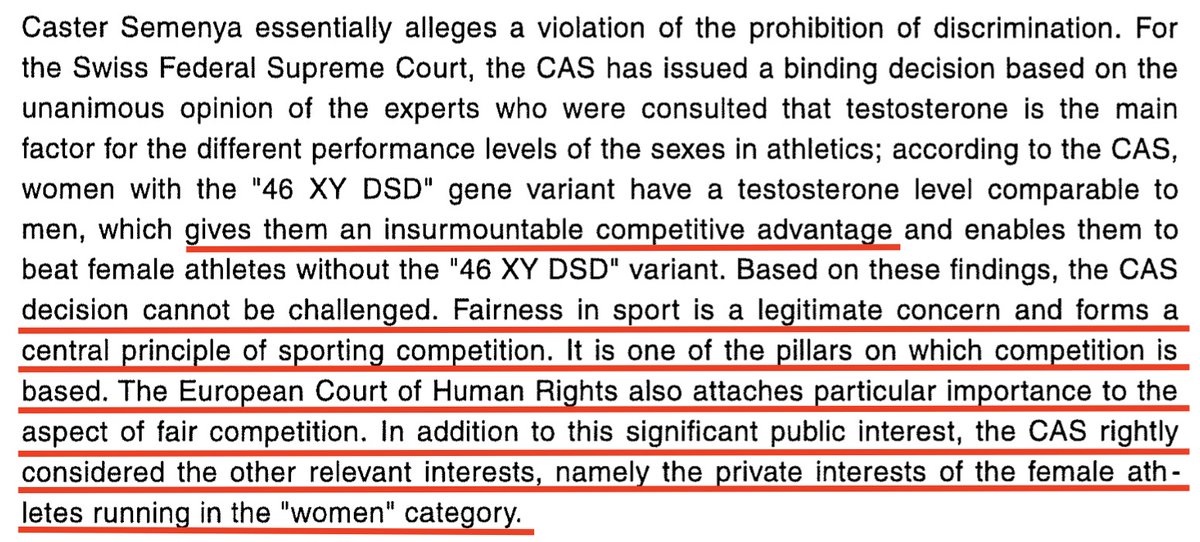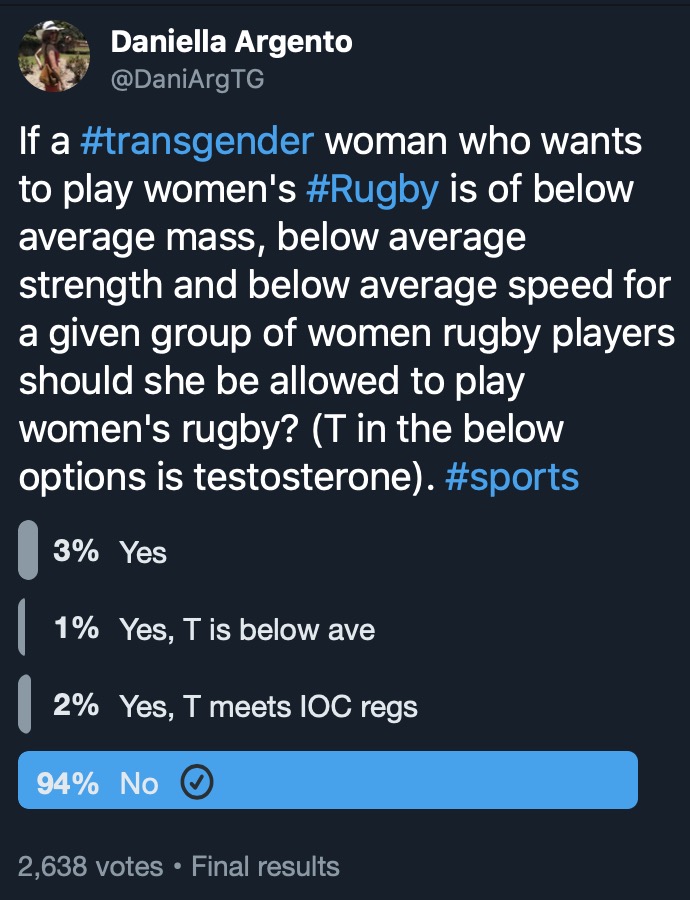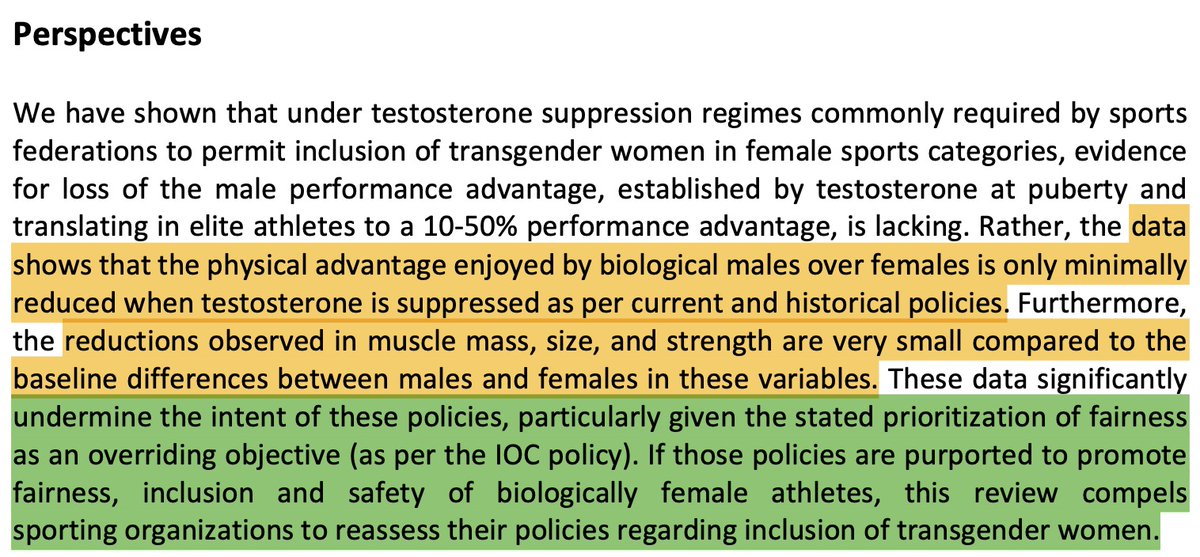
Let me share a few thoughts on the latest #Semenya development - her appeal rejected by the Swiss Supreme court, World Athletics policy supported (pretty strongly too). We are planning a short pod on this tomorrow too, but here are a few thoughts… (1/…)
First, we’ve spoken a lot about transgender athletes recently. That has many elements to it. This has even more, and it’s really an unsolvable situation. It’s been present for nearly 100 years in sport, some horrendous attempts to manage it, and no clean solution in sight (2/…)
This decision establishes, for now, the policy that requires athletes with hyperandrogenism to lower T in order to compete. But not any hyperandrogenism, and not just any events. It covers only that caused by a selection of DSDs, where a person is 46XY, with testes, and thus (3/
…having high T levels. And it covers only events from 400m to the mile. Both are quite important to emphasise - the former makes clear that for World Athletics, this is about “biological male advantage” in women’s sport (they used this phrasing at CAS, it’s in their documents)
The latter is what makes it weird, because biological advantages conferred by T are hugely impactful on performance - it’s the reason that all being equal, one human runs 10% faster than another, because they have “androgenisation” and the other does not. Men vs women, that is (5
I can’t understand how a policy whose principle is that T is the basis of advantage can then isolate four events where it apparently works. It’s not like T chooses which events it wants to give males a boost in! This paradox is a symptom of the dreadful process and research (6/)
…that World Athletics did in this process. That’s a big objection for me. It’s a ridiculous position to arrive at, so arbitrary and internally inconsistent. That said, let me now offer some support to World Athletics on the PRINCIPLE of biological advantage, which is real (7…)
The dividing line between males (for the purpose of sport, those who get this T benefit) and females (those who do not) is essential. Without it, women’s sport loses integrity and sport begins to reward things that do not matter (like would happen if weight classes in boxing were
…ignored for some people who argued “I’m naturally heavier, I should be allowed to fight down in weight”. So WA have a sound principle - at CAS, they argued this really well, actually. It was a strong physiological position. Their research & policy didn’t match its strength (9/)
The other objectionable thing about it is that it creates a situation where a healthy young athlete, with no desire for change and no medical need, is compelled to seek a doctor who’ll prescribe drugs with risk of harm in order to sport. The doctors were rightly concerned about
…medical ethics for this reason. It even became a point raised by medical organisations, advising doctors not to implement. So again, the issue (for me anyway) is not with the principle of it, but rather its implementation. There’s almost a sense in which the “fix” through drugs
…makes the policy ‘untenable’, but it’s ironic that this “fix” is offered as a way to be more inclusive (right or wrong, of course). In any event, WA have made a strong physiological case, and the courts have now agreed twice, on the basis of fairness, and now it remains (12/…)
…to be seen what Semenya does. I see 3 options. First is another appeal, presumably to European Human Rights court. In that context, the language in the decision is interesting - they are very explicit in saying that fair competition is valued by the ECHR. Interesting (13/) 

This whole argument seems like a pre-emptive “closing of the door” on another appeal. Or at least, a ‘prediction’ of its likely failure? Or maybe not (ask a lawyer!). In any event, the time for an appeal is probably long enough that it’s not viable for her to ACT now based on it
Second, she can take the medication. All signs are that she won’t (and I can’t blame her). That means no more 400 to 1500m running. Which leaves option 3 - run a different event. She ran a 23.4s 200m earlier this year, an indication of where her focus may be? (15/)
That’s still too slow for Olympic 200m contention - in Rio 2016, the slowest qualifier into the final was 22.49s, so Semenya needs to improve by a full second to make the final. Medals start at 22.1s. A big leap, time will tell. Incidentally, if she does that, her range (16)
…of performances would span a world class 200m all the way up to a sub-4 min 1500m, would be unprecedented (which is a physiologically interesting, too). What would be really interesting if she does do well in the 200m, is what World Athletics does then? (17/)
World Athletics has indicated that the hyperandrogenism policy is a “living document” and that events can be added to it at any time should evidence emerge for it. Semenya doing well in the 200? Do they act on that “as evidence”? It would look like the policy is chasing Semenya
All in all, a situation without solution, but for a principle of biological sex’s impact on performance, and the defence of women’s sport integrity, it’s right. For policy creation and integrity of science in governance, it’s a disaster. And Semenya is a significant loser (18/)
Sorry, one or two more to add. First, many are using analogies of Michael Phelps’ long arms or big feet, or Usain Bolt’s fast-twitch muscles, to argue that “natural advantages” such as these, and thus Semenya having high T, should be left alone & even celebrated. Let’s assess….
First, sport exists to find exceptional individuals WITHIN categories. We actually want to celebrate things like muscle fibres & neurological advantages in sprinters. We accept that tall people make it in the NBA, that lungs & hearts matter. Sport rewards these attributes (20/)
And that’s precisely why a separate female category is necessary - 2 humans who possess all “the right stuff” to be sprinters or endurance cyclists or tennis players (or pick your sport) will differ by enormous margins if one is male (thus getting T benefits) and the other female
We can see this in every event, where boys outperform the best adult females, even when they’re not as dedicated, well-resourced or talented. Inferior (relative to champions) males outperform historically successful females. They are identical in all respects that matter, and ...
…different in one that should not matter. Hence, a category. It “protects” (sometimes literally) females and allows them to be celebrated deservedly. We do not offer the same “protection” to people with small feet, short arms, slow-twitch muscles, or to short people. (23/)
So these analogies using Phelps’ arms and feet, or Bolt’s muscles are a) tenuous at best, and b) absolutely irrelevant, because until we have a category for short-armed, small-footed swimmers, there is no category crossing to be concerned about. One can, I suppose, lobby for a
…”short person’s NBA" (Under 6-foot etc), but even in scale, these protections are not afforded because they’re small compared to what males have over females. The best small-footed swimmer (size 9 or lower?), for instance, is not beaten by thousands and thousands of “big foots"
So they are unnecessary & unnecessarily complex. So please, lay off spurious analogies. Rather use weight classes in boxing and see if it works if “natural advantage” of weighing 109kg can be allowed into a category for under 70kg. Classes create meaning, so don’t wipe out lines
And that’s about it. As mentioned, we’ll do a podcast, short episode, as soon as possible, and maybe more gets thrown up. But that’s about the extent of my thoughts on an impossible situation, no solution, only ‘victims’. (26/26, the end)
• • •
Missing some Tweet in this thread? You can try to
force a refresh




